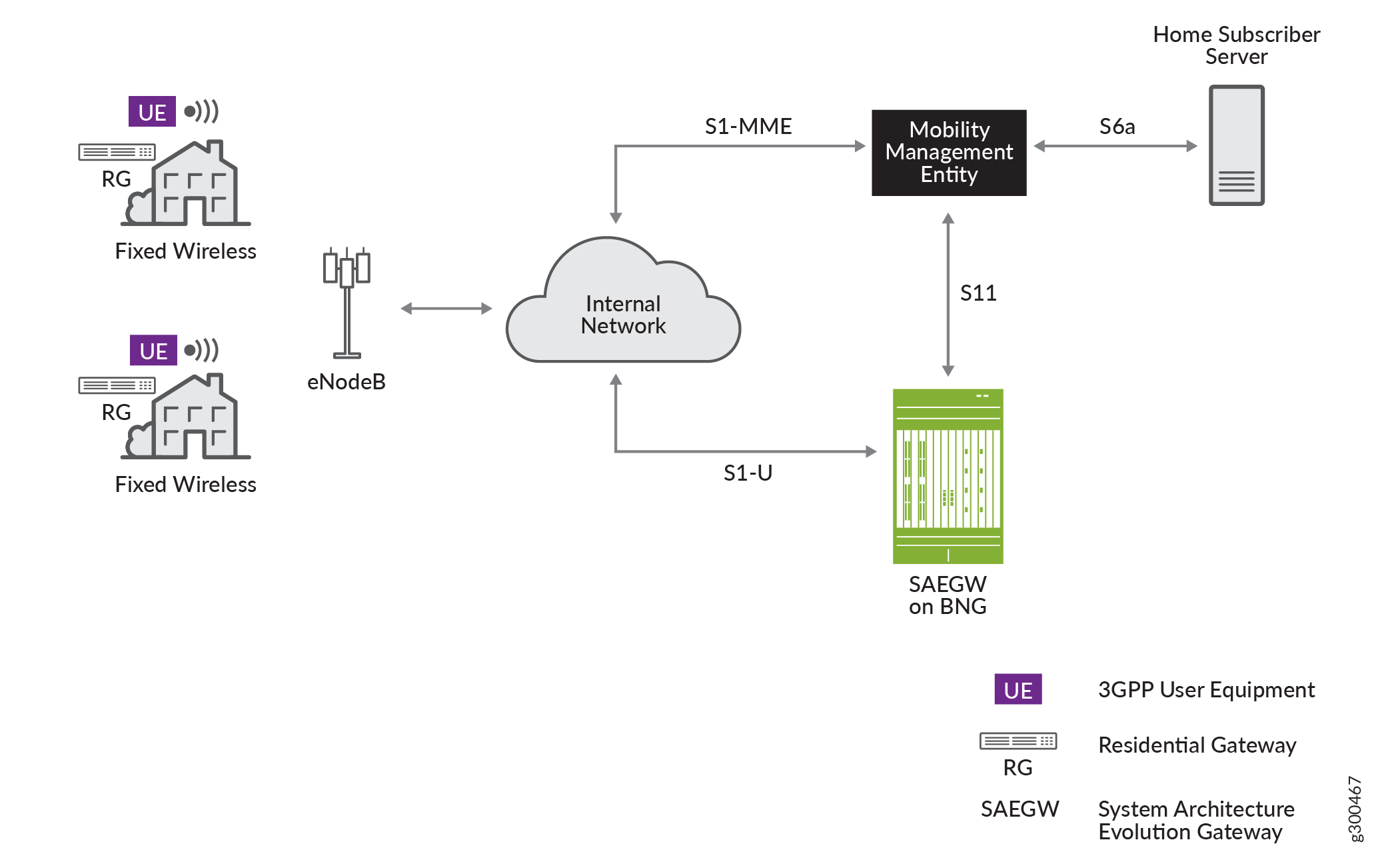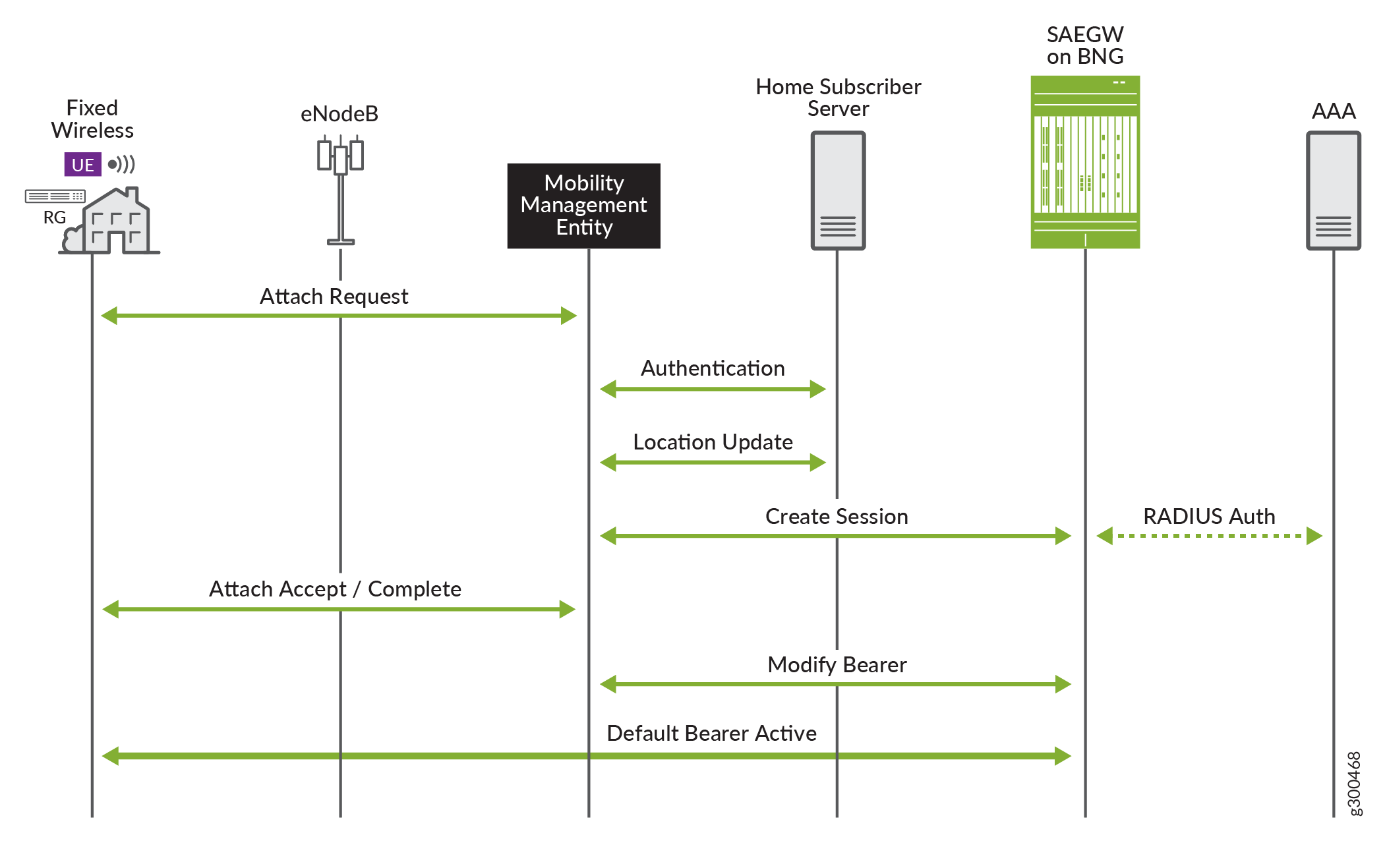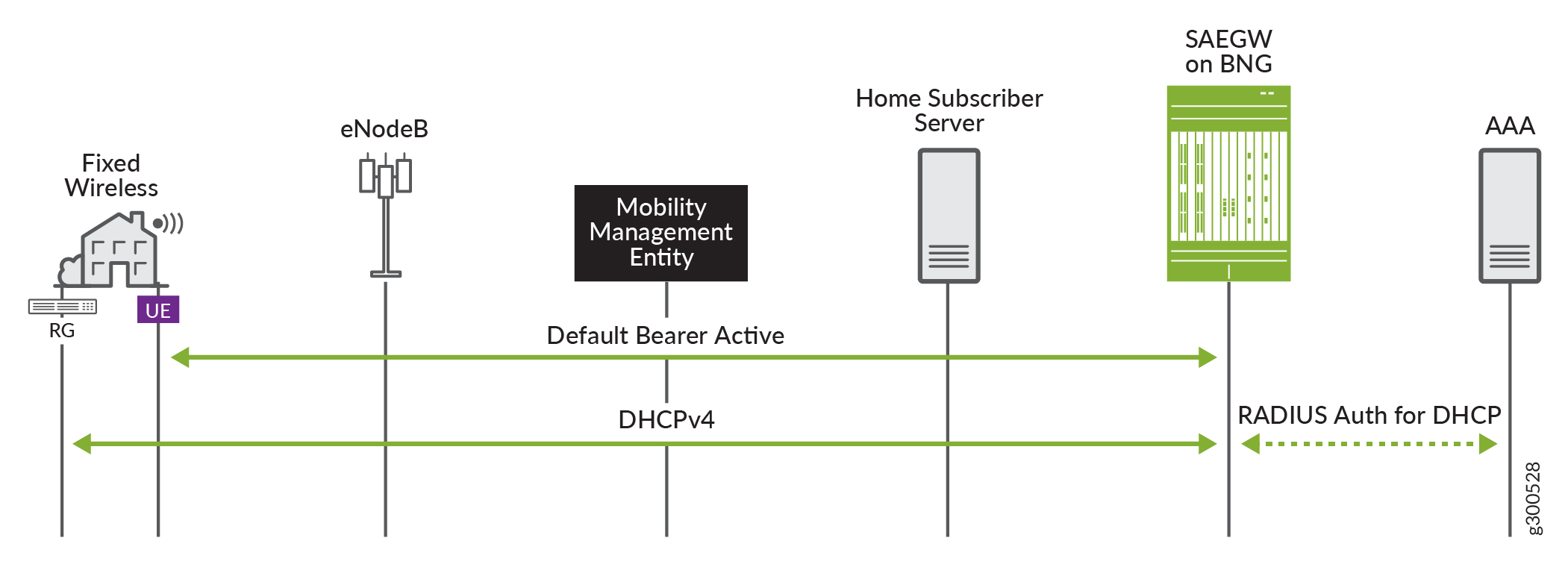Fixed Wireless Access Networks
Fixed Wireless Access Network Overview
Service providers can manage subscribers over a wireless network to the home instead of having to run fiber to the building. The subscribers are in a fixed location, typically a residence, with customer premises equipment (CPE) that exchanges wireless radio signals with the provider network. The wireless network uses a fiber backhaul tower to handle traffic for the last miles from a hard-wired network to the subscribers. Multiple towers can relay traffic between each other to and from the fiber optic network. Starting in Junos OS Release 19.2R1, MX Series routers acting as BNGs can support subscribers in Third-Generation Partnership Project (3GPP) fixed wireless access networks, enabling the integration of fixed wireless subscribers with the wireline subscriber management backend.
You can find a helpful summary of related terminology in Fixed Wireless Access Network Overview.
Figure 1 shows a representative topology for a fixed wireless access network.

Figure 2 shows the GPRS tunneling protocol (GTP) signaling messages in the fixed wireless access network that are necessary to activate and deactivate a default bearer. The messages are actually request and response pairs, but for simplicity the pairs are represented in the figure with bidirectional arrows. The Default Bearer Active line represents the activated default bearer that will carry data traffic.
In this implementation, the UE roaming is not supported.

Briefly, the message exchange sequence is the following:
The user equipment (UE) sends an Attach Request to the eNodeB, which forwards the message to the mobility management entity (MME). The request includes the APN.
The MME exchanges Identity request/response messages with the UE to determine the International Mobile Subscriber Identity (IMSI) or other identifier of the UE.
The MME sends the identifier to the Home Subscriber Server (HSS) to authenticate the UE.
The MME exchanges Location Update request/response messages with the HSS. In this exchange, the MME provides the HSS with its own address. The HSS acknowledges the update and sends subscription information for the UE from its database.
The MME sends a Create Session Request to the System Architecture Evolution gateway (SAEGW). The MME first compares the APN provided by the UE with the APN for which it is authorized according to the subscription information from the HSS. If there is a match, the MME includes that APN in the Create Session Request. If it does not match, then the MME instead includes the APN authorized by the HSS.
The SAEGW performs the following actions:
Validates information elements received in the request.
Validates the APN requested by the subscriber. If you have configured authentication, the BNG communicates with the RADIUS server to accomplish that task.
Receives the R-TEID-C, which consists of the IP address of the S11 interface on the MME and the MME’s allocated identifier.
Allocates the local TEIDs:
The L-TEID-C is the IP address of the S11 interface on the BNG and the BNG’s allocated identifier.
The L-TEID-U is the IP address of the S1-U interface on the BNG and the BNG’s allocated identifier.
Allocates an IP address for the pseudowire interface it creates for the session. The address comes from either a locally configured address pool on the BNG or from the RADIUS server.
Creates the session and sends the Create Session response to the MME. The response includes the IP address that the SAEGW has assigned for the bearer and both L-TEID-C and L-TEID-U.
The MME exchanges messages with the eNodeB, which then establishes the bearer component from the UE to eNodeB.
The UE signals to the eNodeB that attachment is complete; the eNodeB notifies the MME.
The MME and SAEGW exchange Modify Bearer request/response messages to determine the final parameters for the bearer.
When the BNG receives the request, it creates the dynamic pseudowire (
ps) interface that will receive the GTP-U encapsulated data packets from the eNodeB. The BNG creates one dynamicpsinterface per UE. The BNG also receives the R-TEID-U from the eNodeB in the Modify Bearer request. After creating the interface, the BNG sends a Modify Bearer response to the MME.The default bearer is now active and subscriber data traffic can pass back and forth between the UE through eNodeB to the SAEGW and then the connected PDN.
However, if the residential gateway is a DHCP client, it first begins the DHCP message exchange for the subscriber. The exchange takes place on the default bearer. After DHCP operations have completed to bind the subscriber and provide the DHCP configuration, then data traffic passes over the bearer.
The MME and SAEGW also exchange Delete Session request and response messages. When the SAEGW receives the request, it initiates the subscriber logout process, much as it would for a wireline DHCP subscriber.
Figure 3 shows the DHCP connection for the case where the RG creates DHCP subscribers. The DHCP control packets are exceptioned to the Routing Engine as for any other DHCP deployment. The behavior for creating and controlling the DHCP subscribers is the same as for a wireline broadband network. When the subscriber is bound, the UE can then start sending data traffic for the subscriber.

References
For detailed information about all aspects of a fixed wireless network, read the 3GPP technical specifications that define everything. Table 1 lists the most relevant specifications.
Specification Number |
Title |
|---|---|
3GPP TS 23.002 (Release 15) |
Network architecture |
3GPP TS 23.401 (Release 15) |
General Packet Radio Service (GPRS) enhancements for Evolved Universal Terrestrial Radio Access Network (E-UTRAN) access |
3GPP TS 29.274 (Release 15) |
3GPP Evolved Packet System (EPS);Evolved General Packet Radio Service (GPRS) Tunnelling Protocol for Control plane (GTPv2-C)Stage 3 |
3GPP TS 29.281 (Release 15) |
General Packet Radio System (GPRS)Tunnelling Protocol User Plane (GTPv1-U) |
3GPP Fixed Wireless Access Terminology
Table 2 explains terminology used for 3GPP fixed wireless access networks.
Term |
Description |
|---|---|
3GPP |
The 3rd Generation Partnership Project is an international standards organization that develops specifications and protocols for wireless telephony. |
APN |
The access point name identifies the packet data network (PDN), such as the Internet, that the subscriber wants to access. When a subscriber requests access, the UE passes the requested APN to the eNodeB, which sends it to the MME for authorization. If the subscriber does not request an APN, the MME can authorize a default APN. Each PDN that the user subscribes to has an APN and an associated packet data network gateway (PGW) that the UE uses to access the PDN. The combination of APN and PGW is called a PDN subscription context. One context is the default APN, which always connects to a PDN such as the Internet unless the user activates another APN. The HSS maintains subscriber profiles, The MME uses the profile from the HSS to validate whether the subscriber is actually subscribed to the requested APN. You can also think of the APN as the set of service-level and connection parameters—such as QoS parameters—that is authorized for the UE. A given UE can access many APNs. An APN has two parts:
An APN that includes both a Network Identifier and an Operator Identifier corresponds to a DNS name for the PGW. The APN has the following format: network-id.mncmnc-number.mccmcc-number.gprs An APN can be a simple string or more complex, as shown in these examples:
|
Bearer |
A bearer is the tunnel that connects the UE to a PDN through the PGW. A default bearer is established to a default PGW whenever the UE is activated. Activation means here that the UE is on and has performed authentication. A UE device has a default bearer for each PGW to which it connects. For example, if user equipment connects to the Internet through one PGW and a corporate intranet through another PGW, two default bearers will be active. Default bearers are best-effort. The UE can establish dedicated bearers to other PDNs that can have different QoS requirements, such as a guaranteed bit rate (GBR). Bearers encapsulate user data with GTP-U. The GTP-U information is in turn sent over a UDP connection and inside IP packets. |
eNodeB |
The hardware (typically in a radio tower) that connects directly to the UE over the air and to the wireless network core. Also called evolved Node B or E-UTRAN Node B. The eNodeB has the following functions:
|
GPRS |
The general packet radio service is the data standard that defines the specifications that enable wireless networks to carry IP packets to external networks. |
GR |
The home gateway router that provides the interface between the subscriber’s network and the UE. Also called a residential gateway router. |
GTP |
The GPRS tunneling protocol governs the creation and use of GTP tunnels that carry traffic between two GPRS support nodes (GSNs), such as an MME and an SGW. Each GTP tunnel is identified by a TEID. The receiving end of a tunnel assigns locally the TEID that the transmitting side uses. The tunnel endpoints on the nodes exchange messages to communicate the TEID values to each other. |
GTP-C |
The GPRS tunneling protocol, control plane. GTP-C tunnels carry packet data units and signaling messages in the control plane (S11 interface) between tunnel endpoints on the MME and the SAEGW on the BNG. |
GTP-U |
The GPRS tunneling protocol, user plane. GTP-U tunnels carry packet data units and signaling messages in the user (data) plane (S1-U interface) between tunnel endpoints on the eNodeB and the SAEGW on the BNG. |
HSS |
The Home Subscriber Server maintains a database of subscriber and service information. This information supports call (connection) control and session management. The HSS has the following functions:
|
IMSI |
The International Mobile Subscriber Identity number that identifies a 3GPP subscriber. The IMSI consists of a mobile country code, a mobile network code, and a mobile station identification number. |
MEI |
The Mobile Equipment Identity number that uniquely identifies the subscriber device. |
MME |
The mobility management entity is the control node for the wireless access network, communicating with eNodeB, HSS, and SAEGW. Some of its functions include the following:
|
MSISDN |
The Mobile Subscriber ISDN Number (telephone number) that is assigned to the mobile subscriber. |
PGW |
The packet data network gateway provides the UE with connectivity to external networks such as the Internet. Traffic to and from the UE is processed by the PGW. The BNG functions as an SAEGW, which includes the functions of both PGW and SGW. The PGW performs the following functions:
|
S11 |
The GTPv2-based control plane interface that connects the MME and the SAEGW on the BNG. GTP-C tunnels carry control messages. An S11 interface can support multiple MMEs. |
S1-MME |
The GTPv2-based control plane interface that connects eNodeB and the MME. |
S1-U |
The GTPv1-based user plane interface that connects eNodeB and the SAEGW on the BNG. S1-U is also called the data plane interface. GTP-U tunnels on the interface carry user payloads. An S1-U interface can support multiple eNodeBs. |
S6a |
Interface that connects the MME and the HSS, which use this interface to exchange subscriber, service, and UE information. |
SAEGW |
The System Architecture Evolution gateway that includes the functions of both the SGW and the PGW. It enables the BNG to act as both SGW and PGW. |
SGW |
The serving gateway routes and forwards subscriber data packets. The BNG functions as an SAEGW, which includes the functions of both PGW and SGW. The SGW performs the following functions:
|
TEID |
A tunnel endpoint identifier that uniquely identifies a GTP tunnel endpoint in the scope of a path. A fully qualified TEID consists of an IP address concatenated with a locally allocated identifier. Four TEIDs are defined, together they uniquely identify a default bearer session:
|
UE |
The user equipment that connects to the wireless network’s eNodeB and to the subscriber’s network. UE corresponds to what is called CPE in other contexts. In some cases, the UE consists of a SIM card and a residential gateway router (RG) that can host the SIM. In other cases the SIM might be in a separate device that connects to the RG. In both cases, the SIM provides the wireless radio connectivity to eNodeB in the fixed wireless access network. |
Benefits of Fixed Wireless Access
Reduce last-mile installation and maintenance costs by using radio backhaul towers connected to hard-wired network instead of providing fiber to the building.
Ability to increase service offerings to underserved end users.
How to Configure Fixed Wireless Access
The fixed wireless access configuration enables the SAEGW on the BNG. At a minimum you must configure an APN, the control plane and the data plane.
The following procedure assumes that you have configured separately any of the following that apply for your APN:
Access profile
Dynamic profile
Anchor point interface
Address pool
To configure fixed wireless access on the BNG:
For example, the following configuration specifies the S11 interface address as 192.0.2.30 and the S1-U interface address as 192.0.2.100. The pseudowire anchor is ps0. The APN is named internet-basic; it has both an access profile for RADIUS parameters and a dynamic client profile attached. The authentication password is $ABC123. The username includes the domain name example.net and the subscriber’s IMSI. The data type is the required IPv4. A descriptive string, fwa-basic-subscribers-phoenix, is associated with the APN.
The APN uses the default routing instance, because no other routing instance is configured. IP addresses are supplied by RADIUS, because the configuration does not specify a local pool.
fixed-wireless-access {
anchor-point ps0;
control-plane mme-45 {
s11 {
v4-address ip-address;
}
}
data-plane x-s1u-20 {
s1-u {
v4-address 192.0.2.100;
}
}
apn internet-basic {
aaa-profile fwa-radius-prof;
apn-data-type ipv4
authentication {
password $ABC123;
username-include {
domain-name example.net;
imsi;
}
}
description fwa-basic-subscribers-phoenix;
dynamic-profile fwa-dyn-profile;
}
}
The dynamic profile that you attach to the APN creates the dynamic interface for fixed wireless access. The following configuration is a simple example:
dynamic-profiles fwa-dyn-profile {
interfaces {
"$junos-interface-ifd-name" {
unit "$junos-interface-unit" {
family inet {
unnumbered-address lo0.0 preferred-source-address 10.0.0.1;
}
}
}
}
}
The anchor point interface configuration is also very simple. For example:
interfaces {
ps0 {
anchor-point {
rlt-0/1/10;
}
flexible-vlan-tagging;
}
}
Verifying and Monitoring Fixed Wireless Access
Purpose
Determine status information and statistics for fixed wireless access configurations.
Action
To display a list of all interfaces on the BNG supporting fixed wireless access subscribers:
user@host>show subscribers client-type fixed-wireless-access
To display detailed information about fixed wireless access subscribers, including username and IP address, dynamic profile, local and remote TEIDs, and remote and local IP addresses for the BNG connection to eNodeBs and MMEs:
user@host>show subscribers client-type fixed-wireless-access detail
To view statistics for messages exchanged between the BNG, eNodeB, and MME:
user@host>show services fixed-wireless-access statistics
Change History Table
Feature support is determined by the platform and release you are using. Use Feature Explorer to determine if a feature is supported on your platform.
